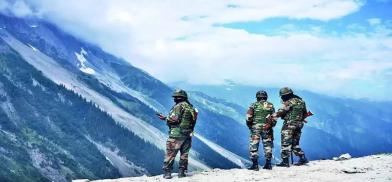With increased militarisation, is a PLA demobilisation possible in Ladakh?
Vacating the Kailash Range without linking it to PLA withdrawal from Depsang-Demchok was a strategic blunder, proving how easily China cons our negotiators. Our political hierarchy wouldn't know how poorly this decision was viewed by our units/soldiers

China’s Foreign Ministry spokesperson Mao Ning said in a media briefing on September 13, 2024 that Chinese and Indian militaries realized disengagement in four areas and the situation along the border is stable. Her comments come a day after India’s External Affairs Minister S Jaishankar said in Geneva that about 75 percent of the “disengagement problems” with China are sorted out but the bigger issue has been the increasing militarization of the frontier.
Jaishankar met his counterpart Wang Yi., who is also a member of the Communist Party of China Politburo, on July 25, 2024 on the sidelines of the ASEAN foreign ministers' meetings in Vientiane, Laos, where, according to India’s Ministry of External Affairs (MEA), both ministers agreed to work with a purpose and urgency to achieve complete disengagement at the earliest.
On September 12, 2024, India's National Security Adviser Ajit Doval met Wang Yi at St. Petersburg, Russia where they “reportedly” agreed to deliver on the common understandings reached by the leaders of both countries, enhance mutual trust, create conditions for improving bilateral ties and maintain communication to that end.
Doval also met Russian President Vladimir Putin to brief him on Prime Minister Narendra Modi’s visit to Ukraine. This was despite Modi having spoken to Putin about his peace efforts on return from Kyiv.
No change in ground situation
Earlier on August 29, 2024, the 31st meeting of the Working Mechanism for Consultation & Coordination on India-China Border Affairs was held at Beijing, where according to the MEA the two sides had a frank, constructive and forward-looking exchange of views on the situation along the Line of Actual Control (LAC) to narrow down differences and early resolution of the outstanding issues.
The above is being projected as a remarkable new development; an outstanding diplomatic victory, with some posts on social media applauding that PLA has withdrawn from “disputed areas” (https://x.com/mrsinha_/status/1834865463353831779?s=48&t=vJ_2EfImi2o0kVm6c8EDCQ).
However, there has been no change in the ground situation after Indian and Chinese troops disengaged from Patrolling Point 15 (PP-15) in the Gogra-Hot Springs area during September 2020. The claim of 75% disengagement appears dubious with PLA lodged 20-km inside Depsang, and crossed the LAC at Demchok as well. The Ladakhis have lost traditional grazing grounds, while Indian troops cannot patrol 26 out of 65 PPs, although these PPs were established years back “short” of the LAC.
In 2020, the PLA crossed west of China’s 1959 claim line, which India never recognized, and redrew a new LAC in Eastern Ladakh (https://news4masses.com/new-lac-in-ladakh/?amp=1). Following disengagements, buffer zones were established in Indian territory, saying patrolling in buffer zones would be discussed subsequently. But China hasn’t allowed patrolling and keeps these zones under surveillance.
After the disengagement in September 2020, statements during/after various meetings only amounted to diplomatic jargon with little substance; China has been signaling there will be no more PLA withdrawal.
PLA consolidated new locations
India committed two cardinal sins: one, not calling China “aggressor” from day one, which enabled China dub India aggressor, blaming it also for the Galwan clash; two, vacating the Kailash Range (Indian territory) with own positions overlooking Chinese positions, especially PLA’s Moldo Garrison, in exchange to the PLA withdrawing from Finger 3 to Finger 10 on North Bank of Pangong Tso – both these locations continue to be connected with metalled road and PLA has deployed tanks at Finger 10.
Vacating the Kailash Range without linking it to PLA withdrawal from Depsang-Demchok was a strategic blunder, proving how easily China cons our negotiators. Our political hierarchy wouldn't know how poorly this decision was viewed by our units/soldiers, some of whom were moved from Roorkee to occupy Kailash Range.
PLA has consolidated the new locations it occupied in Eastern Ladakh during 2020. Since 2020, China has increased force deployment in border areas along the LAC and added firepower, according to the US Department of Defense’ ‘China Military Power Report’ released on October 19, 2023. (https://www.defense.gov/News/Releases/Release/Article/3561549/dod-releases-2023-report-on-military-and-security-developments-involving-the-pe/).
Subramanian Swamy, BJP member and former Member Parliament, says during the SCO Summit in Uzbekistan (September 2022), attended by PM Modi and Chinese President Xi Jinping, China distributed maps showing Arunachal Pradesh and Ladakh part of China and J&K part of Pakistan.. The new pro China-Pakistan regime in Bangladesh raises the Chinese threat to a higher level.
It is being said that Putin is working on resolving India-China differences and China is mellowing on the border issue with New Delhi allowing Chinese investments in India, easing visas for Chinese technicians etc. Another view is that India has decided to let China keep what it took in 2020 and it is Hindi-Chini Bhai-Bhai once again.
Can India make China pull back when China eyes minerals of Ladakh, fresh-water source of Siachen Glacier and the Pangong Tso? Will China vacate Depsang after Home Minister Amit Shah banged the table in Parliament saying, “We will take back Aksai Chin”?
In 2022, China announced a second expressway through Aksai Chin (G-695 highway), which is to run close to Galwan and Hot Springs. Its planned completion by 2035 may be earlier looking at China's pace of developing border infrastructure. China annexed Aksai Chin to give depth to its National Highway 219. Hence, China will attempt capturing more of Ladakh to provide depth to G-695 much before it reaches Galwan and Hot Springs. China’s new bridge over Pangong Tso allows quick mobilization of additional PLA and mechanized forces in Ladakh. Demobilization certainly looks impossible.
(The author is an Indian Army Veteran. Views are personal)
Read more at: https://www.southasiamonitor.org/indo-pacific-china-watch/increased-militarisation-pla-demobilisation-possible-ladakh#comment-19125









Post a Comment